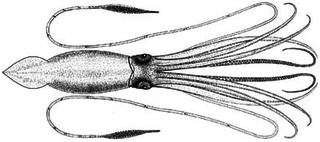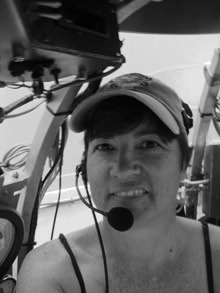
The Mariana Trench is an oceanic trench located in the western Pacific Ocean, about 200 kilometres (124 mi) east of the Mariana Islands; it is the deepest oceanic trench on Earth. It is crescent-shaped and measures about 2,550 km (1,580 mi) in length and 69 km (43 mi) in width. The maximum known depth is 10,984 ± 25 metres at the southern end of a small slot-shaped valley in its floor known as the Challenger Deep. The deepest point of the trench is more than 2 km (1.2 mi) farther from sea level than the peak of Mount Everest.

Bioluminescence is the production and emission of light by living organisms. It is a form of chemiluminescence. Bioluminescence occurs widely in marine vertebrates and invertebrates, as well as in some fungi, microorganisms including some bioluminescent bacteria, and terrestrial arthropods such as fireflies. In some animals, the light is bacteriogenic, produced by symbiotic bacteria such as those from the genus Vibrio; in others, it is autogenic, produced by the animals themselves.

The giant squid is a species of deep-ocean dwelling squid in the family Architeuthidae. It can grow to a tremendous size, offering an example of abyssal gigantism: recent estimates put the maximum size at around 12–13 m (39–43 ft) for females and 10 m (33 ft) for males, from the posterior fins to the tip of the two long tentacles. The mantle of the giant squid is about 2 m long, and the length of the squid excluding its tentacles rarely exceeds 5 m (16 ft). Claims of specimens measuring 20 m (66 ft) or more have not been scientifically documented.

Sylvia Alice Earle is an American marine biologist, oceanographer, explorer, author, and lecturer. She has been a National Geographic Explorer at Large since 1998. Earle was the first female chief scientist of the U.S. National Oceanic and Atmospheric Administration, and was named by Time Magazine as its first Hero for the Planet in 1998.

Bigfin squids are a group of rarely seen cephalopods with a distinctive morphology. They are placed in the genus Magnapinna and family Magnapinnidae. Although the family was described only from larval, paralarval, and juvenile specimens, numerous video observations of much larger squid with similar morphology are assumed to be adult specimens of the same family.

Don Walsh is an American oceanographer, explorer and marine policy specialist. He and Jacques Piccard were aboard the bathyscaphe Trieste when it made a record maximum descent into the Challenger Deep on January 23, 1960, the deepest point of the world's oceans. The depth was measured at 35,813 feet (10,916 m), but later and more accurate measurements have measured it at 35,798 feet (10,911 m).

USNS Indomitable (T-AGOS-7) was a United States Navy Stalwart-class ocean surveillance ship in service from 1985 to 2002. From 2003 until 18 June 2014, she was in commission in the National Oceanic and Atmospheric Administration (NOAA) as the oceanographic research ship NOAAS McArthur II. As of 2018 it serves as a mother ship now named the Deep Submersible Support Vessel (DSSV) Pressure Drop for the crewed deep-ocean research submersible DSV Limiting Factor.
Tsunemi Kubodera is a Japanese zoologist with the National Museum of Nature and Science. On September 30, 2004, Kubodera and his team became the first people to photograph a live giant squid in its natural habitat. Two years later, on December 4, 2006, he also managed to successfully film a live adult giant squid for the first time ever. On July 10, 2012, Kubodera, together with Steve O'Shea and Edith Widder, became the first to film a live giant squid in its natural habitat from a submersible off the Bonin Islands.

Atolla wyvillei, also known as the Atolla jellyfish or Coronate medusa, is a species of deep-sea crown jellyfish. It lives in oceans around the world. Like many species of mid-water animals, it is deep red in color. This species was named in honor of Sir Charles Wyville Thomson, chief scientist on the Challenger expedition.

Pyrocystis fusiformis is a non-motile, tropical, epipelagic, marine dinoflagellate, reaching lengths of up to 1 millimetre (0.039 in). P. fusiformis display bioluminescence when disturbed or agitated. In coastal marine waters, this dinoflagellate causes glowing effects after dark. P. fusiformis was first described in the Proceedings of the Royal Society of London in 1876.

The colossal squid is the largest member of its family Cranchiidae, the cockatoo or glass squids, with its second largest member being Megalocranchia fisheri. It is sometimes called the Antarctic cranch squid or giant squid and is believed to be the largest squid species in terms of mass. It is the only recognized member of the genus Mesonychoteuthis and is known from only a small number of specimens. The species is confirmed to reach a mass of at least 495 kilograms (1,091 lb), though the largest specimens—known only from beaks found in sperm whale stomachs—may perhaps weigh as much as 600–700 kilograms (1,300–1,500 lb), making it the largest known invertebrate. Maximum total length has been estimated at 14–18 metres (46–59 ft). The colossal squid has the largest eyes of any known creature ever to exist, with an estimated diameter of 27 cm (11 in).

Pisces V is a type of crewed submersible ocean exploration device, powered by battery, and capable of operating to depths of 2,000 metres (6,600 ft), a depth that is optimum for use in the sea waters around the Hawaiian Islands. It is used by scientists to explore the deep sea around the underwater banks in the main Hawaiian Islands, as well as the underwater features and seamounts in the Northwestern Hawaiian Islands, specifically around Kamaʻehuakanaloa Seamount.

Counter-illumination is a method of active camouflage seen in marine animals such as firefly squid and midshipman fish, and in military prototypes, producing light to match their backgrounds in both brightness and wavelength.

Michael V. deGruy was an American documentary filmmaker specializing in underwater cinematography. His credits include Life in the Freezer, Trials of Life, The Blue Planet and Pacific Abyss. He was also known for his storytelling, including a passionate TED talk about his love of the ocean on the Mission Blue Voyage. His company, Film Crew Inc., specialized in underwater cinematography, filming for the BBC, PBS, National Geographic, and the Discovery Channel. His notable accomplishments include diving beneath thermal vents in both the Atlantic and Pacific oceans. He was a member of many deep sea expeditions and was a part of the team that first filmed the vampire squid and the nautilus.

Baited remote underwater video (BRUV) is a system used in marine biology research. By attracting fish into the field of view of a remotely controlled camera, the technique records fish diversity, abundance and behaviour of species. Sites are sampled by video recording the region surrounding a baited canister which is lowered to the bottom from a surface vessel or less commonly by a submersible or remotely operated underwater vehicle. The video can be transmitted directly to the surface by cable, or recorded for later analysis.
OceanX is an ocean exploration initiative founded by Mark Dalio and Ray Dalio, founder of investment firm Bridgewater Associates, an initiative by Dalio Philanthropies, OceanX is a “mission to explore the ocean and bring it back to the world. OceanX combines science, technology and media to explore and raise awareness for the oceans and “create a community engaged with protecting them.” The initiative also supports and facilitates ocean research for scientists, science institutions, media companies and philanthropy partners.

Nathan Jack Robinson is a marine biologist and science communicator from the United Kingdom. During his career, Robinson has been at the center of several viral videos. These have included videos of him removing a plastic drinking straw from the nostril of a sea turtle as well as a plastic fork from the nostril of a different sea turtle, and a video recorded by him and Edith Widder of a live giant squid. This video is the first-time that a live giant squid has been recorded in US waters and is the second time this species has ever been caught alive on film.

Alan J. Jamieson is a Scottish marine biologist, engineer, explorer and author, best known for his deep-sea exploration and study of life at the deepest places in the oceans. He is known for extensive use of deep-sea landers to establish the maximum depth and community dynamics of many organismal groups, as well as the discovery of many new species and highlighting the presence of anthropogenic impacts at full ocean depth. During the Five Deeps Expedition, and follow on expeditions in 2020, he completed various dives in a manned submersible to some of the deepest places in the world. He has published over 100 scientific papers and participated in 65 deep-sea expeditions.
















